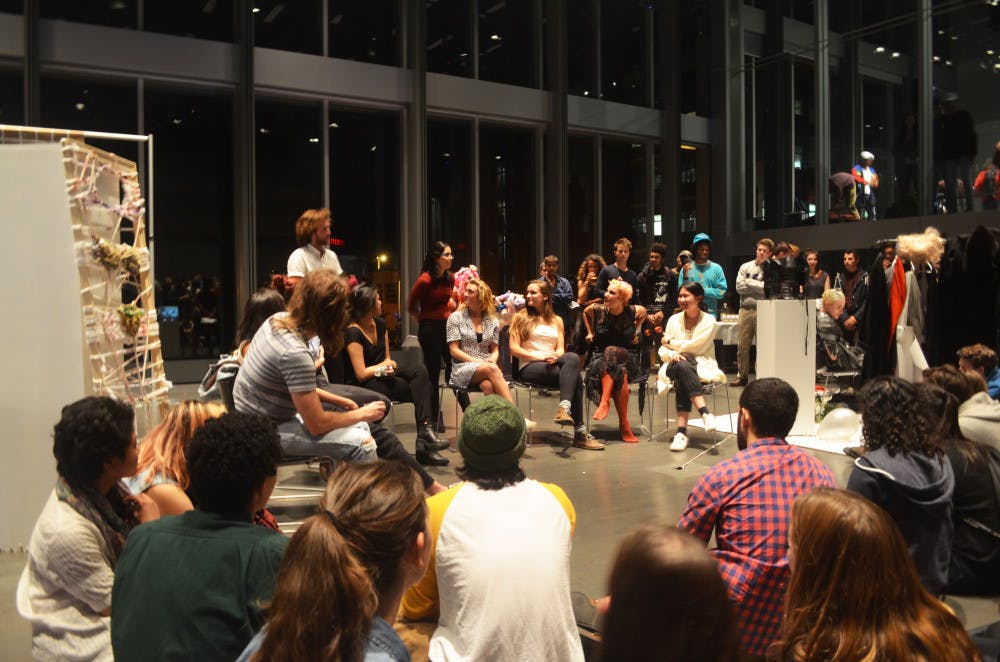The Granoff Center for the Creative Arts came alive Friday night as students flocked to MESH, weaving through rooms with flickering projections, glittering spikes and people dancing with roses between their teeth. The annual fall event of art and music was organized by the Student Creative Arts Council.
MESH kicked off at noon with (De)construction, in which 10 artists from Brown and the Rhode Island School of Design began creating their own pieces before rotating at 5 p.m. to finish one of their fellow artists’ pieces. Live music started at around 8 p.m., featuring the student band richard and several MCs, and then the space began to fill with guests.
Isabela Muci ’16 and Jake Brodsky ’16, co-directors of SCAC, said the architecture of the Granoff Center went hand-in-hand with this year’s MESH. Standing in the room where the band was playing, students could simultaneously see the artists working below, thanks to Granoff’s unique split-level design.
“This is one of the best MESHes because they utilized the space of Granoff,” said attendee Kat DaSilva ’15.5.
The event allows people to see the process behind an exhibition, from “an artist working on the art to the art being installed on the wall,” Muci said.
“That gap between production and exhibition is often what makes art alienating to a lot of people,” Brodsky said. “The ability to show the transparency and what happens in that gap is a way to very much bring people into the fold.”
True to its name, MESH incorporated a blend of many different media: computer animation, sculpture, laser cut-plastic and even performance art.
One of the works was a collaboration started by Sarah Cheung ’16 and completed by Jennifer Avery ’16.5. Cheung began the piece as a cardboard sculpture of metallic spikes, and Avery incorporated it as a prop in her performance art piece, during which she dyed another student’s hair grey.
Avery took the opportunity to deviate from her usual style, which typically includes “hacking up teddy bears and dolls and assembling them in terrifying ways,” she said.
Cheung said this was the first visual art collaboration she has worked on, adding that her style usually utilizes plaster, wood and metal, and explores the overlap between nature and artificial and personal experience through repeated forms.
Meanwhile, a collaborative installation by RISD students Kendall Lane, Zoe Schlacter and Amelia Zhang featured a laptop on a bright pink table, in the center of a dark room. Viewers could walk in and Skype one of the artists, who in turn sat in a room with a backdrop festooned with fairy lights and pink drapery, imitating a typical teenage girl’s bedroom.
The piece comments on the popular phenomenon of self-help videos on YouTube, discussing topics from mental health to makeup. Rather than “mocking or subverting” these videos, the three artists aimed to pursue the same discussion in an alternative space through their installation, Lane said.
“This type of culture, a lot of times it’s seen as lesser, but we’re reclaiming it and embracing it,” Schlacter said.
“I feel like there’s a really strong heterosexual ideal or norm that these girls represent,” Zhang added, pointing out that their piece questions these norms.
The event catered even to students who do not consider themselves art lovers. “I’ve never been to the Granoff, but I will say this art show has made me want to come back again,” said attendee Jackson Cantrell ’18. “The art really came alive (when) the audience showed up, because so much of it is interactive, so much of it is seeing the art in conjunction with the party.”
After the artists had finished a roundtable discussion of their work, the audience was free to mingle with the artwork. People flowed in and out of the studio throughout the night, looking at a video of the artists at work, socializing with the rest of the attendees or simply soaking in the atmosphere and artwork. “This event allowed me to spend more time with the art,” Cantrell said.
“You’re supposed to have these transparent walls to actually interact with each other, but mostly we just have classes in them,” Muci said. “This is one of the few times that Granoff has actually been used for its purpose, which is to actually connect these spaces.”

ADVERTISEMENT




